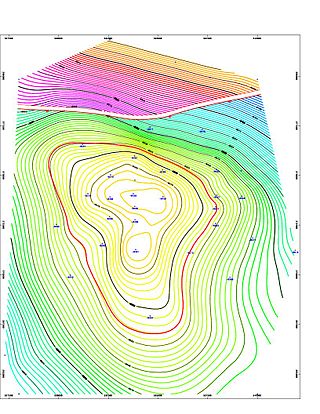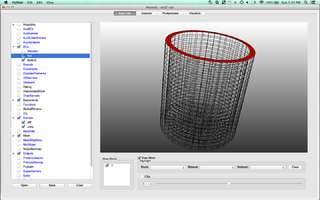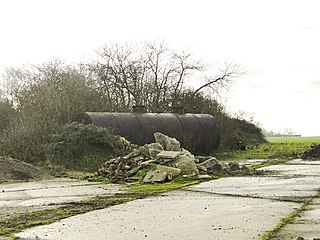Related Research Articles

An aquifer is an underground layer of water-bearing material, consisting of permeable or fractured rock, or of unconsolidated materials. Aquifers vary greatly in their characteristics. The study of water flow in aquifers and the characterization of aquifers is called hydrogeology. Related terms include aquitard, which is a bed of low permeability along an aquifer, and aquiclude, which is a solid, impermeable area underlying or overlying an aquifer, the pressure of which could lead to the formation of a confined aquifer. The classification of aquifers is as follows: Saturated versus unsaturated; aquifers versus aquitards; confined versus unconfined; isotropic versus anisotropic; porous, karst, or fractured; transboundary aquifer.

Hydrogeology is the area of geology that deals with the distribution and movement of groundwater in the soil and rocks of the Earth's crust. The terms groundwater hydrology, geohydrology, and hydrogeology are often used interchangeably.
Permeability in fluid mechanics and the Earth sciences is a measure of the ability of a porous material to allow fluids to pass through it.

Geologic modelling,geological modelling or geomodelling is the applied science of creating computerized representations of portions of the Earth's crust based on geophysical and geological observations made on and below the Earth surface. A geomodel is the numerical equivalent of a three-dimensional geological map complemented by a description of physical quantities in the domain of interest. Geomodelling is related to the concept of Shared Earth Model; which is a multidisciplinary, interoperable and updatable knowledge base about the subsurface.

The Kansas Geological Survey (KGS) is a research and service division of the University of Kansas, charged by statute with studying and providing information on the geologic resources of Kansas. The KGS has no regulatory authority and does not take positions on natural resource issues.

Groundwater recharge or deep drainage or deep percolation is a hydrologic process, where water moves downward from surface water to groundwater. Recharge is the primary method through which water enters an aquifer. This process usually occurs in the vadose zone below plant roots and is often expressed as a flux to the water table surface. Groundwater recharge also encompasses water moving away from the water table farther into the saturated zone. Recharge occurs both naturally and through anthropogenic processes, where rainwater and or reclaimed water is routed to the subsurface.
Subsurface flow, in hydrology, is the flow of water beneath earth's surface as part of the water cycle.
Soil vapor extraction (SVE) is a physical treatment process for in situ remediation of volatile contaminants in vadose zone (unsaturated) soils. SVE is based on mass transfer of contaminant from the solid (sorbed) and liquid phases into the gas phase, with subsequent collection of the gas phase contamination at extraction wells. Extracted contaminant mass in the gas phase is treated in aboveground systems. In essence, SVE is the vadose zone equivalent of the pump-and-treat technology for groundwater remediation. SVE is particularly amenable to contaminants with higher Henry’s Law constants, including various chlorinated solvents and hydrocarbons. SVE is a well-demonstrated, mature remediation technology and has been identified by the U.S. Environmental Protection Agency (EPA) as presumptive remedy.
Groundwater models are computer models of groundwater flow systems, and are used by hydrologists and hydrogeologists. Groundwater models are used to simulate and predict aquifer conditions.
FEFLOW is a computer program for simulating groundwater flow, mass transfer and heat transfer in porous media and fractured media. The program uses finite element analysis to solve the groundwater flow equation of both saturated and unsaturated conditions as well as mass and heat transport, including fluid density effects and chemical kinetics for multi-component reaction systems.
GSSHA is a two-dimensional, physically based watershed model developed by the Engineer Research and Development Center of the United States Army Corps of Engineers. It simulates surface water and groundwater hydrology, erosion and sediment transport. The GSSHA model is used for hydraulic engineering and research, and is on the Federal Emergency Management Agency (FEMA) list of hydrologic models accepted for use in the national flood insurance program for flood hydrograph estimation. Input is best prepared by the Watershed Modeling System interface, which effectively links the model with geographic information systems (GIS).

KIVA is a family of Fortran-based Computational Fluid Dynamics software developed by Los Alamos National Laboratory (LANL). The software predicts complex fuel and air flows as well as ignition, combustion, and pollutant-formation processes in engines. The KIVA models have been used to understand combustion chemistry processes, such as auto-ignition of fuels, and to optimize diesel engines for high efficiency and low emissions. General Motors has used KIVA in the development of direct-injection, stratified charge gasoline engines as well as the fast burn, homogeneous-charge gasoline engine. Cummins reduced development time and cost by 10%–15% using KIVA to develop its high-efficiency 2007 ISB 6.7-L diesel engine that was able to meet 2010 emission standards in 2007. At the same time, the company realized a more robust design and improved fuel economy while meeting all environmental and customer constraints.
Reactive transport modeling in porous media refers to the creation of computer models integrating chemical reaction with transport of fluids through the Earth's crust. Such models predict the distribution in space and time of the chemical reactions that occur along a flowpath. Reactive transport modeling in general can refer to many other processes, including reactive flow of chemicals through tanks, reactors, or membranes; particles and species in the atmosphere; gases exiting a smokestack; and migrating magma.

MOOSE is an object-oriented C++ finite element framework for the development of tightly coupled multiphysics solvers from Idaho National Laboratory. MOOSE makes use of the PETSc non-linear solver package and libmesh to provide the finite element discretization.
Hydrogeophysics is a cross-disciplinary area of research that uses geophysics to determine parameters and monitor processes for hydrological studies of matters such as water resources, contamination, and ecological studies. The field uses knowledge and researchers from geology, hydrology, physics, geophysics, engineering, statistics, and rock physics. It uses geophysics to provide quantitative information about hydrogeological parameters, using minimally invasive methods. Hydrogeophysics differs from geophysics in its specific uses and methods. Although geophysical knowledge and methods have existed and grown over the last half century for applications in mining and petroleum industries, hydrogeological study sites have different subsurface conditions than those industries. Thus, the geophysical methods for mapping subsurface properties combine with hydrogeology to use proper, accurate methods to map shallow hydrological study sites.

Non-aqueous phase liquids, or NAPLs, are organic liquid contaminants characterized by their relative immiscibility with water. Common examples of NAPLs are petroleum products, coal tars, chlorinated solvents, and pesticides. Strategies employed for their removal from the subsurface environment have expanded since the late-20th century.
Aquifer thermal energy storage (ATES) is the storage and recovery of thermal energy in subsurface aquifers. ATES can heat and cool buildings. Storage and recovery is achieved by extraction and injection of groundwater using wells. Systems commonly operate in seasonally. Groundwater that is extracted in summer cools by transferring heat from the building to the water by means of a heat exchanger. The heated groundwater is reinjected into the aquifer, which stores the heated water. In wintertime, the flow is reversed - heated groundwater is extracted.
Bioclogging or biological clogging is the clogging of pore space in soil by microbial biomass; their body and their byproducts such as extracellular polymeric substance (EPS). The microbial biomass blocks the pathway of water in the pore space, forming a certain thickness of the impermeable layer in the soil, and it reduces the rate of infiltration of water remarkably.

J. Jaime Gómez-Hernández is a Spanish civil engineer specialized in geostatistics and hydrogeology. He is a full professor of hydraulic engineering at the School of Civil Engineering of the Technical University of Valencia. He was conferred the William Christian Krumbein Medal in 2020 from the International Association for Mathematical Geosciences. He also received the 2020 Prince Sultan bin Abdulaziz International Prize for Water in the field of groundwater.

Fault zone hydrogeology is the study of how brittlely deformed rocks alter fluid flows in different lithological settings, such as clastic, igneous and carbonate rocks. Fluid movements, that can be quantified as permeability, can be facilitated or impeded due to the existence of a fault zone. This is because different mechanisms that deform rocks can alter porosity and permeability within a fault zone. Fluids involved in a fault system generally are groundwater and hydrocarbons.
References
- ↑ Keating, H. Elizabeth; B.A. Robinson; V.V. Vesselinov (2005). "Development and application of numerical models to estimate fluxes through the regional aquifer beneath the Pajarito Plateau". Vadose Zone Journal. 4 (3): 653–671. doi:10.2136/vzj2004.0101.
- ↑ Kwicklis, M. Edward; A.V. Wolfsberg; P.H. Stauffer; M.A. Walvroord; M.J. Sully (2006). "Multiphase Multicomponent Parameter Estimation for Liquid and Vapor Fluxes in Deep Arid Systems Using Hydrologic Data and Natural Environmental Traces". Vadose Zone Journal. 5 (3): 934–950. doi:10.2136/vzj2006.0021.
- ↑ Stauffer, H. Philip; H.S. Viswanathan; R.J. Pawar; G.D. Guthrie (2009). "A system model for geologic sequestration of carbon dioxide". Environmental Science & Technology. 43 (3): 565–570. Bibcode:2009EnST...43..565S. doi: 10.1021/es800403w . PMID 19244984.
- ↑ Tenma, Norio; T. Yamaguchi; G. Zyvoloski (2008). "The Hijiori Hot Dry Rock test site, Japan Evaluation and optimization of heat extraction from a two-layered reservoir". Geothermics. 37: 19–52. doi:10.1016/j.geothermics.2007.11.002.
- ↑ Robinson, A. Bruce; Viswanathan, H.S.; Valocchi, A.J. (2000). "Efficient numerical techniques for modeling multicomponent ground-water transport based upon simultaneous solution of strongly coupled subsets of chemical components" (PDF). Advances in Water Resources. 23 (4): 307–324. Bibcode:2000AdWR...23..307R. doi:10.1016/S0309-1708(99)00034-2.
- ↑ Sakamoto, Y; T. Komai; T. Kawamura; H. Minagawa; N. Tenma; et al. (2007). "Modification of permeability model and history matching of laboratory-scale experiment for dissociation process of methane hydrate: Part 2 - Numerical study for estimation of permeability in methane hydrate reservoir". Int. J. Offshore Polar Eng.
- ↑ Hutnak, M; Fisher, AT; Zuhlsdorff, L; Spiess, V; Stauffer, PH; Gable, CW (2006). "Hydrothermal recharge and discharge guided by basement outcrops on 0.7-3.6 Ma seafloor east of the Juan de Fuca Ridge: Observations and numerical models". Geochemistry, Geophysics, Geosystems. 7 (7): Q07O02. Bibcode:2006GGG.....707O02H. doi: 10.1029/2006GC001242 .
- ↑ Chaudhuri A, Rajaram H, Viswanathan HS, Zyvoloski GA, Stauffer PH (2009). "Buoyant convection resulting from dissolution and permeability growth in vertical limestone fractures". Geophysical Research Letters. 36 (3): L03401. Bibcode:2009GeoRL..36.3401C. doi: 10.1029/2008GL036533 .
- ↑ Zyvoloski, A. George (2007). FEHM: A control volume finite element code for simulating subsurface multi-phase multi-fluid heat and mass transfer (Report). Los Alamos Unclassified Report LA-UR-07-3359.